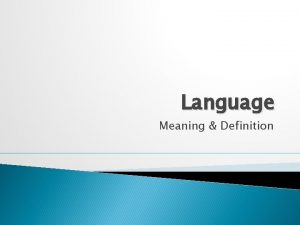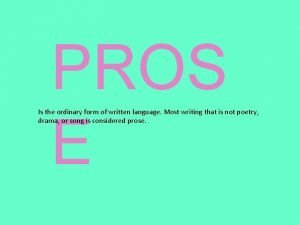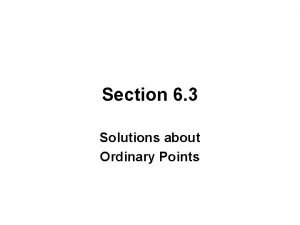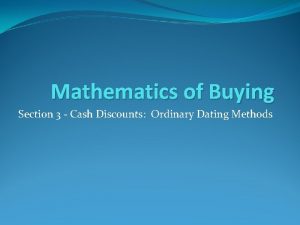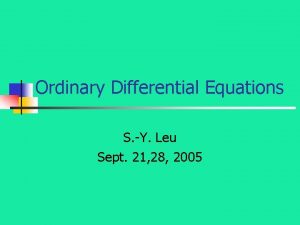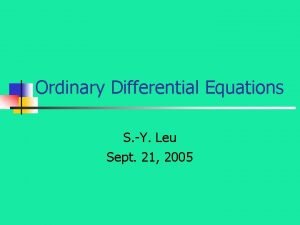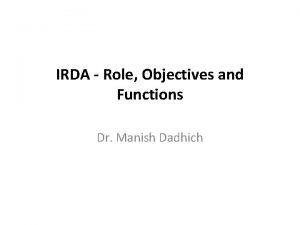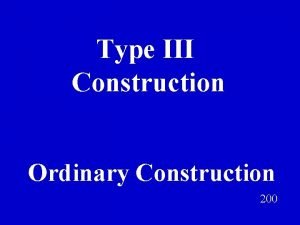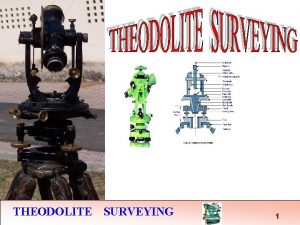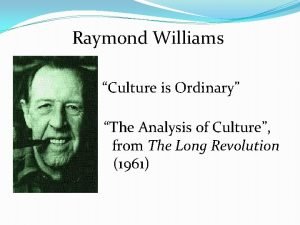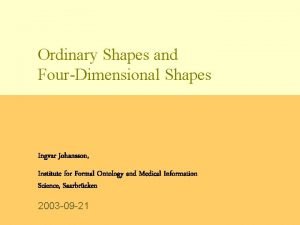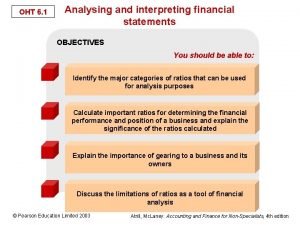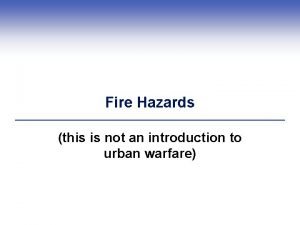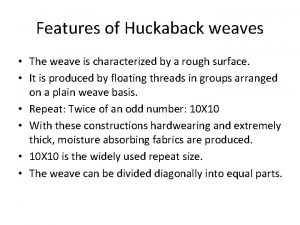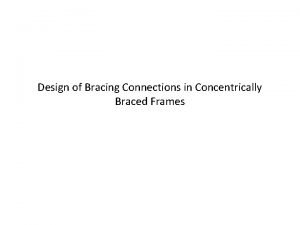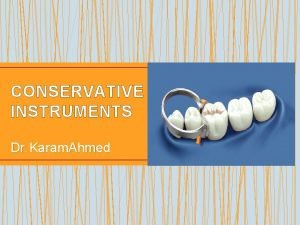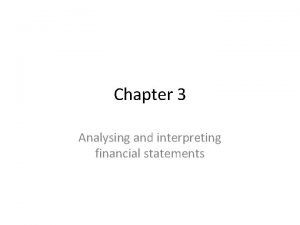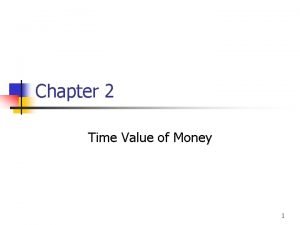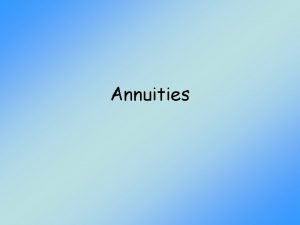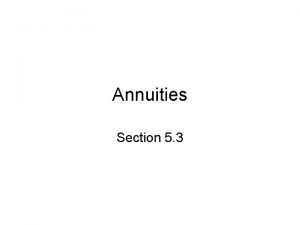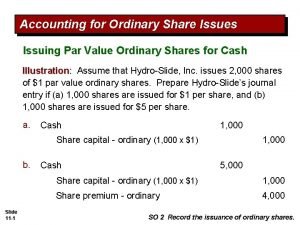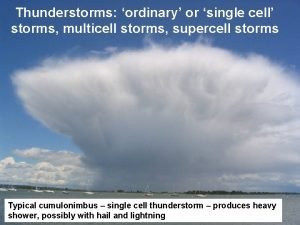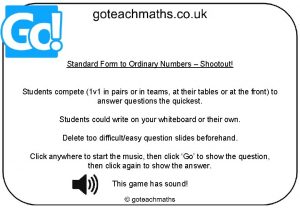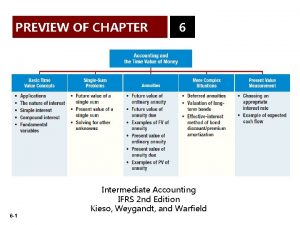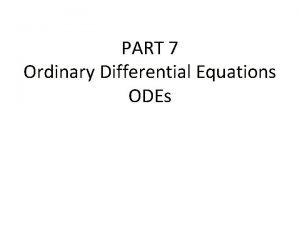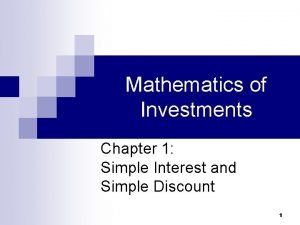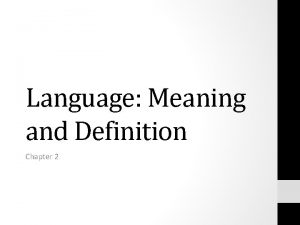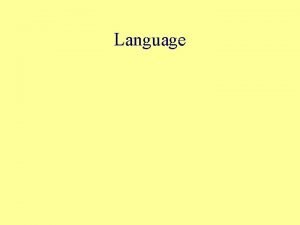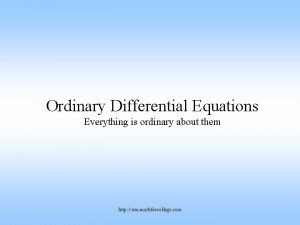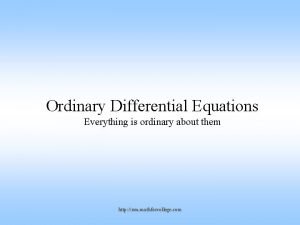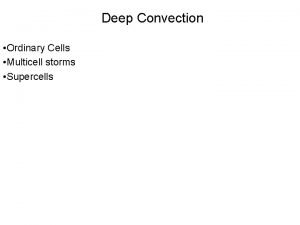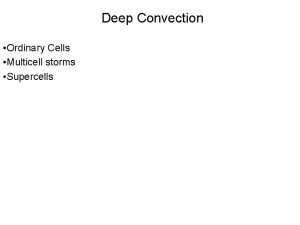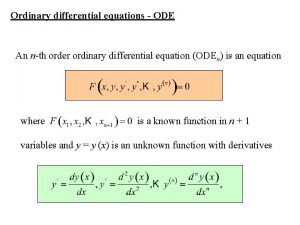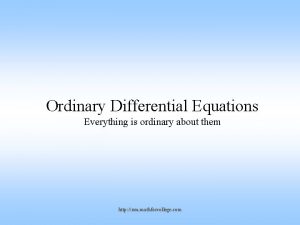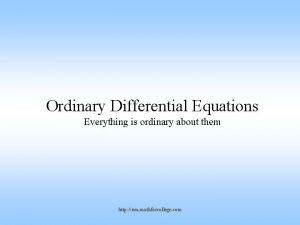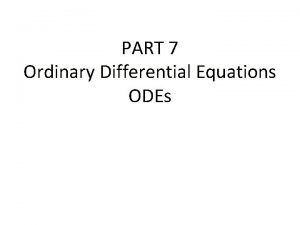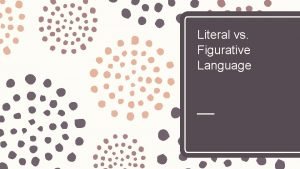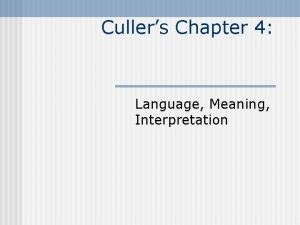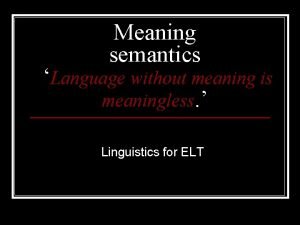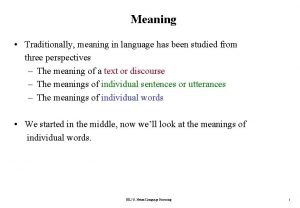Language Meaning Definition Functions of Ordinary Language Ordinary





















































- Slides: 53

Language Meaning & Definition

Functions of Ordinary Language Ordinary language serves a wide variety of functions. . . ◦ ◦ ◦ Conveying information Asking questions Greeting people and saying goodbye Expressing emotions Issuing commands Etc. . .

Functions of Ordinary Language Ordinary language serves a wide variety of functions. . . ◦ ◦ ◦ Conveying information Asking questions Greeting people and saying goodbye Expressing emotions Issuing commands Etc. . . For the sake of this class, we will focus on two functions of language in particular:

Functions of Ordinary Language Ordinary language serves a wide variety of functions. . . ◦ ◦ ◦ Conveying information Asking questions Greeting people and saying goodbye Expressing emotions Issuing commands Etc. . . For the sake of this class, we will focus on two functions of language in particular: ◦ Conveying information ◦ Expressing and evoking feelings

Cognitive vs Emotive Meanings These two functions correspond to two different forms of meaning.

Cognitive vs Emotive Meanings These two functions correspond to two different forms of meaning: ◦ Cognitive meaning Terminology that conveys factual information has a cognitive meaning.

Cognitive vs Emotive Meanings These two functions correspond to two different forms of meaning: ◦ Cognitive meaning Terminology that conveys factual information has a cognitive meaning. ◦ Emotive meaning Terminology that expresses or evokes feelings has an emotive meaning.

2. 1 Varieties of Meaning Conveying cognitive meaning:

2. 1 Varieties of Meaning Conveying cognitive meaning: “Texas has executed more inmates than any other state. ”

2. 1 Varieties of Meaning Conveying cognitive meaning: “Texas has executed more inmates than any other state. ” Conveying emotive meaning:

2. 1 Varieties of Meaning Conveying cognitive meaning: “Texas has executed more inmates than any other state. ” Conveying emotive meaning: “The death penalty is disgusting. ”

2. 1 Varieties of Meaning Emotionally charged statements tend to have both forms of meaning – “The death penalty is a cruel and inhuman form of punishment. ” The cognitive meaning of the above statement is a value claim.

2. 1 Varieties of Meaning Value claims are claims that something is right or wrong, good or bad, important or not important.

2. 1 Continued Disguising Value Claims ◦ Value claims need to be defended, the same way factual claims do. ◦ Using emotive terms is sometimes used to try and “bypass” that in an argument.

2. 1 Defective Cognitive Meanings

2. 1 Defective Cognitive Meanings There are two ways in which the cognitive meaning of a term can be ‘defective’: ◦ Vagueness ◦ Ambiguity

2. 1 Continued Vagueness Vague expressions are those that allow for a continuous range of interpretations.

2. 1 Continued Vagueness Vague expressions are those that allow for a continuous range of interpretations. ◦ Examples of vague terms/expressions: I love my husband, but I also love Game of Thrones. Who counts as ‘tall’? Most students are ‘tall’ compared to a hobbit, but not compared to your average NBA player. When does your hair go from ‘thinning’ to ‘balding’? What counts as ‘art’?

2. 1 Continued Ambiguity describes a different type of uncertainty.

2. 1 Continued Ambiguity describes a different type of uncertainty. Ambiguous expressions are those that can be interpreted as having more than one clearly distinct meaning in a given context.

2. 1 Continued Ambiguity describes a different type of uncertainty. Ambiguous expressions are those that can be interpreted as having more than one clearly distinct meaning in a given context. ◦ Examples of ambiguous expressions: A “light” beer may be light in taste, color, or calories. In “drawing” a weapon, you may be preparing to attack someone, or be making a pretty picture.

Verbal vs Factual Disputes Vagueness and ambiguity sometimes lead to disputes that are merely over the meaning of particular terms.

Verbal vs Factual Disputes There are two different kinds of disputes to remember: ◦ Verbal disputes ◦ Factual disputes

Verbal vs Factual Disputes VERBAL DISPUTES Verbal disputes are disputes over the meaning of words.

Verbal vs Factual Disputes VERBAL DISPUTES Verbal disputes are disputes over the meaning of words. Art, for example, is a vague term. If we arguing over whether John Cage’s musical piece 4’ 33” is art, we are engaged in a verbal dispute.

Verbal vs Factual Disputes FACTUAL DISPUTES

Verbal vs Factual Disputes FACTUAL DISPUTES Factual disputes are disagreements that arise over what the fact of the matter is.

Verbal vs Factual Disputes FACTUAL DISPUTES Factual disputes are disagreements that arise over what the fact of the matter is. For example: If I say that I have three teaching assistants, and Kaetlin and Rick say that I only have two, we are having a factual dispute.

2. 2 The Intension and Extension of Terms

2. 2 Terms, Intension & Extension A term is any word or arrangement of words that can serve as the subject of a statement.

2. 2 Terms, Intension & Extension A term is any word or arrangement of words that can serve as the subject of a statement. ◦ Examples are: Names/nouns (‘Barack Obama’, ‘vegetable’, ‘fennec fox’) Descriptive phrases (‘the strongest man in the world’, ‘Ancient Greece’) Concepts (‘speed’, ‘ugliness’)

2. 2 Terms, Intension & Extension A term is any word or arrangement of words that can serve as the subject of a statement. ◦ Examples are: Names/nouns (‘Barack Obama’, ‘vegetable’, ‘fennec fox’) Descriptive phrases (‘the strongest man in the world’, ‘Ancient Greece’) Concepts (‘speed’, ‘ugliness’) ◦ Non-terms: Prepositions (‘to’, ‘from’) Adverbs and non-subject adjectives (‘quickly’, ‘ugly’)

2. 2 Continued Intensional Meaning and Connotation: ◦ Intensional meaning consists of the qualities or attributes that the term connotes.

2. 2 Continued Intensional Meaning and Connotation: ◦ Intensional meaning consists of the qualities or attributes that the term connotes. For example, the term “dog” connotes fourleggedness, furriness, friendliness, and all the other properties we think of dogs as having

2. 2 Continued Intensional Meaning and Connotation: ◦ Intensional meaning consists of the qualities or attributes that the term connotes. For example, the term “dog” connotes fourleggedness, furriness, friendliness, and all the other properties we think of dogs as having Those properties are the connotation of the word ‘dog’

2. 2 Continued Extensional Meaning and Denotation: The extensional meaning of a term consists of the members of the class that the term denotes.

2. 2 Continued Extensional Meaning and Denotation: The extensional meaning of a term consists of the members of the class that the term denotes. ◦ The extensional meaning of ‘dog’ could be given by a list of things that are all dogs, for example: Daschunds Pitbulls Poodles Bulldogs Golden retrievers

2. 2 Continued Extensional Meaning and Denotation: The extensional meaning of a term consists of the members of the class that the term denotes. ◦ The extensional meaning of ‘dog’ could be given by a list of things that are all dogs, for example: Daschunds Pitbulls Poodles Bulldogs Golden retrievers ◦ The above list partially represents the denotation of the term ‘dog. ’

2. 2 Continued Some terms have an intension, but no extension: they have an empty extension.

2. 2 Continued Some terms have an intension, but no extension: they have an empty extension. For example, ‘unicorn’ has an empty extension.

2. 2 Continued Some terms have an intension, but no extension: they have an empty extension. For example, ‘unicorn’ has an empty extension. However, it does have an intension (fourlegged, horselike, horn-having)

2. 2 Continued To improve on our definition of vagueness, vague terms are terms that have an uncertain extension: it’s not clear what the term should count as denoting.

2. 2 Organizing Terms in a Series One way to practice understanding these concepts better is to try ordering lists of terms in a series by the size of their intension or extension.

2. 2 Organizing Terms in a Series Increasing and Decreasing Intension: ◦ Increasing intension is when each term in the series (except the first) connotes more attributes than the one preceding it.

2. 2 Organizing Terms in a Series Increasing and Decreasing Intension: ◦ Increasing intension is when each term in the series (except the first) connotes more attributes than the one preceding it. ◦ Each term in the series after the first is more specific than the one preceding it. ◦ Decreasing intension is the reverse of this order.

2. 2 Organizing Terms in a Series Example: Increasing Intension Object Organism Plant Tree Maple Tree

2. 2 Organizing Terms in a Series Example: Increasing Intension Object Organism Plant Tree Maple Tree As intension increases, the attributes connoted by the terms increase in number.

2. 2 Continued Increasing and Decreasing Extension:

2. 2 Continued Increasing and Decreasing Extension: ◦ Increasing extension is when each term in a series (except the first) denotes a class having more members than the class of the term preceding it.

2. 2 Continued Increasing and Decreasing Extension: ◦ Increasing extension is when each term in a series (except the first) denotes a class having more members than the class of the term preceding it. ◦ In other words, the class size gets larger with each successive term. ◦ Decreasing extension is the reverse of this order.

2. 2 Continued Example: Increasing Extension Maple Tree Plant Organism Object

2. 2 Continued Example: Increasing Extension Maple Tree Plant Organism Object As extension increases, each term describes a class with more and more entities in it.

2. 2 Try it automobile, vehicle, object, Ford Mustang, sports car List the above in order of: 1) increasing intension 2) increasing extension
 Increasing and decreasing intension and extension
Increasing and decreasing intension and extension Writing in its ordinary form
Writing in its ordinary form Ordinary point differential equation
Ordinary point differential equation What is ordinary dating method
What is ordinary dating method Non linear ode
Non linear ode Non-linear ode
Non-linear ode Characteristic equation
Characteristic equation Absolute value as a piecewise function
Absolute value as a piecewise function How to solve evaluating functions
How to solve evaluating functions Evaluating functions and operations on functions
Evaluating functions and operations on functions What are the humanities
What are the humanities Arts appreciation subject
Arts appreciation subject Duties and functions of irda
Duties and functions of irda Specific ordinary item examples
Specific ordinary item examples Type 3 ordinary construction
Type 3 ordinary construction Starving in fire fighting
Starving in fire fighting Annuity due future value formula
Annuity due future value formula Method of repetition and reiteration
Method of repetition and reiteration Finding nemo hero
Finding nemo hero Eu ordinary legislative procedure
Eu ordinary legislative procedure Culture is ordinary summary
Culture is ordinary summary Intermediate accounting chapter 15
Intermediate accounting chapter 15 Formation of partial differential equations ppt
Formation of partial differential equations ppt Perseus ordinary world
Perseus ordinary world Ordinary shapes
Ordinary shapes Ordinary people summary
Ordinary people summary Current ratio graph
Current ratio graph Gingival margin trimmer uses
Gingival margin trimmer uses Mulan crossing the threshold
Mulan crossing the threshold Hope is green
Hope is green Individual characteristics of glass
Individual characteristics of glass Ordinary combustible material
Ordinary combustible material Stage of fire
Stage of fire Ordinary combustible material
Ordinary combustible material Mock leno fabric
Mock leno fabric Ru
Ru Dycal applicator function
Dycal applicator function Annuity due vs ordinary annuity
Annuity due vs ordinary annuity Return on shareholders fund formula
Return on shareholders fund formula Annuity due vs ordinary annuity
Annuity due vs ordinary annuity Ordinary annuity examples
Ordinary annuity examples Sinking fund formula
Sinking fund formula Return on ordinary shareholders equity formula
Return on ordinary shareholders equity formula Multicell storm
Multicell storm Balancing in theodolite
Balancing in theodolite What is reiteration method in surveying
What is reiteration method in surveying Ordinary numbers
Ordinary numbers Present value of deferred annuity
Present value of deferred annuity Midpoint method formula
Midpoint method formula How to find principal formula
How to find principal formula Ordinary method of slices example
Ordinary method of slices example Fire extinguisher introduction
Fire extinguisher introduction Why is critical reading an active process of discovery
Why is critical reading an active process of discovery Ordinary men robert browning
Ordinary men robert browning
